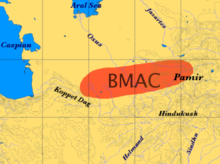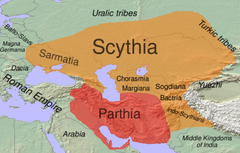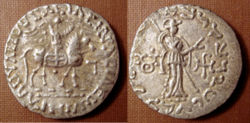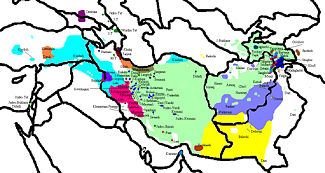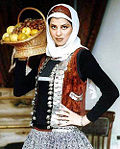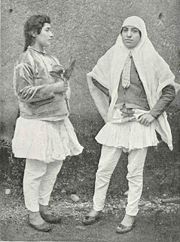Iranian peoples
2008/9 Schools Wikipedia Selection. Related subjects: Peoples
The Iranian peoples are a collection of ethnic groups, defined along linguistic lines as speaking Iranian languages. They are spread across the Iranian plateau, stretching from the Hindu Kush to central Anatolia and from Central Asia to the Persian Gulf - a region that is sometimes termed Greater Iran. Speakers of Iranian languages, however, were once found throughout Eurasia, from the Balkans to western China. As Iranian peoples are not confined to the borders of the current state of Iran, the term Iranic peoples is sometimes used to avoid confusion with the citizens of Iran.
The series of ethnic groups which comprise the Iranian peoples are traced to a branch of the ancient Indo-European Aryans known as the Iranians or Proto-Iranians. Archaeological finds in Russia, Central Asia and the Middle East have elucidated some scant information about the way of life of these early peoples. The Iranian peoples have played an important role throughout history: the Achaemenid Persians established one of the world's first multi-national states and the Scythian- Sarmatian nomads dominated the vast expanses of Russia and western Siberia for centuries with a group of Sarmatian warrior women possibly being the inspiration for the Greek legend of the Amazons. In addition, the various religions of the Iranian peoples, including Zoroastrianism and Manichaeism, are believed by some scholars to be important early philosophical influences on Judeo-Christianity. Early Iranian tribes are the ancestors of many modern peoples, including Persians, Kurds, Pashtuns and many other groups.
Etymology and usage
The term Iranian is derived from Iran (from Aryānām, (lit: "Land of the Aryans"). The old Proto-Indo-Iranian term Arya, per Thieme meaning "hospitable", is believed to have been one of the self-referential terms used by the Aryans, at least in the areas populated by Aryans who migrated south from Central Asia. In the late part of the Avesta (Vendidad 1) one of their homelands was referred to as Airyanem Vaejah. The homeland varied in its geographic range, the area around Herat ( Pliny's view) and even the entire expanse of the Iranian plateau ( Strabo's designation)..
From a linguistic standpoint, the term Iranian peoples is similar in its usage to the term Germanic peoples, which includes various peoples who speak Germanic languages such as German, English and Dutch, Norwegian, or the term Slavic peoples, which includes various speakers of Slavic languages including Russians, Poles, Croats or Serbs. Thus, along similar lines, the Iranian peoples include not only the Persians and Tajiks (or eastern Persians) of Iran, Afghanistan and Tajikistan, but also the Pashtuns, Kurds, Ossetians, Zazas, Baloch and others. The academic usage of the term Iranian peoples or Iranic peoples is distinct from the state of Iran and its various citizens (who are all Iranian by nationality and thus popularly referred to as Iranians) in the same way that Germanic peoples is distinct from Germans. Many citizens of Iran are not necessarily "Iranian peoples" by virtue of not being speakers of Iranian languages and may not have discernible ties to ancient Iranian tribes.
History and settlement
Roots
Having descended from the Proto-Indo-Iranians, the Proto-Iranians separated from the Indo-Aryans, Dards (variously considered as Indo-Iranian or within the Indo-Aryan branch), and the Nuristanis in the early 2nd millennium BCE, in Central Asia. The area between northern Afghanistan, the Aral Sea and the Urals is hypothesized to have been the region where the Proto-Iranians first emerged, following the separation of the Indo-Iranians, in the area of the previous, non-Indo-European Bactria-Margiana Archaeological Complex, a Bronze Age culture of Central Asia.
By the early 1st millennium, Ancient Iranian peoples such as Medes, Persians, Bactrians and Parthians populated the Iranian plateau, while others such as the Scythians, Cimmerians, Sarmatians and Alans populated the steppes north of the Black Sea. The Saka and Scythian tribes spread as far west as the Balkans and as far east as Xinjiang.
The division into an " Eastern" and a " Western" group by the early 1st millennium is visible in Avestan vs. Old Persian, the two oldest known Iranian languages. The Old Avestan texts known as the Gathas are believed to have been composed by Zoroaster, the founder of Zoroastrianism, with the Yaz culture (ca. 1500–1100 BC) as a candidate for the development of Eastern Iranian culture.
Old Persian appears to have been established in written form by 519 BCE, following the creation of the Old Persian script, inspired by the cuneiform script of the Assyrians.
Western Iranians
During the first centuries of the first millennium BCE, the ancient Persians established themselves in the western portion of the Iranian plateau and appear to have interacted considerably with the Elamites and Babylonians, while the Medes also entered in contact with the Assyrians. Remnants of the Median language and Old Persian show their common Proto-Iranian roots, emphasized in Strabo and Herodotus' description of their languages as very similar to the languages spoken by the Bactrians and Soghdians in the east. Following the establishment of the Achaemenid Empire, the Persian language spread from Fars to various regions of the empire, with the modern dialects of Iran, Afghanistan (also known as Dari) and Central-Asia (known as Tajiki) descending from Old Persian.
Old Persian is first attested in the Behistun Inscription (ca. 519 BC), recording a proclamation by Darius I of Persia. In southwestern Iran, the Achaemenid kings usually wrote their inscriptions in trilingual form ( Elamite, Babylonian and Old Persian) while elsewhere other languages were used. The administrative languages were Elamite in the early period, and later Imperial Aramaic.
The early inhabitants of the Achaemenid Empire appear to have adopted the religion of Zoroastrianism. Other prominent Iranian peoples, such as the Kurds, are surmised to stem from Iranic populations that mixed with Caucasian peoples such as the Hurrians, due to some unique qualities found in the Kurdish language that mirror those found in Caucasian languages. The Baloch who speak a west Iranian language relate an oral tradition regarding their migration from Aleppo, Syria around the year 1000 AD, whereas linguistic evidence links Balochi to Kurdish and Zazaki.
Eastern Iranians
While the Iranian tribes of the south are better known through their texts and modern counterparts, the tribes which remained largely in the vast Eurasian expanse are known through the references made to them by the ancient Greeks, Persians, Indo-Aryans as well as by archaeological finds. Many ancient Sanskrit texts make references to tribes like Sakas, Paradas, Kambojas, Bahlikas, Uttaramadras, Madras, Lohas, Parama Kambojas, Rishikas, Tukharas or Tusharas etc and locate them in the ( Uttarapatha) (north-west) division, in Central Asia, around Hindukush range. The Greek chronicler, Herodotus (5th century BC) makes references to a nomadic people, the Scythians; he describes as having dwelt in what is today southern Russia.
It is believed that these Scythians were conquered by their eastern cousins, the Sarmatians, who are mentioned by Strabo as the dominant tribe which controlled the southern Russian steppe in the 1st millennium AD. These Sarmatians were also known to the Romans, who conquered the western tribes in the Balkans and sent Sarmatian conscripts, as part of Roman legions, as far west as Roman Britain.
The Sarmatians of the east became the Alans, who also ventured far and wide, with a branch ending up in Western Europe and North Africa, as they accompanied the Germanic Vandals during their migrations. The modern Ossetians are believed to be the sole direct descendants of the Alans, as other remnants of the Alans disappeared following Germanic, Hunnic and ultimately Slavic migrations and invasions.
Some of the Saka-Scythian tribes in Central Asia would later move further south and invade the Iranian plateau and northwestern India (see Indo-Scythians). Another Iranian tribe related to the Saka-Scythians were the Parni in Central Asia, and who later become indistinguishable from the Parthians, speakers of a northwest-Iranian language. Many Iranian tribes, including the Khwarezmians, Massagetae and Sogdians, were assimilated and/or pushed out of Central Asia by the migrations of Turkic tribes emanating out of Xinjiang and Siberia.
The most dominant surviving Eastern Iranians are represented by the Pashtuns, whose origins are generally believed to be in southern Afghanistan, from which they began to spread until they reached as far west as Herat and as far east as the Indus in the modern state of Pakistan. The Pashto language shows affinities to the Avestan and Bactrian; both Bactrian and Pashto languages are of Middle Iranian origin.
The modern Sariqoli in southern Xinjiang and the Ossetes of the Caucasus are remnants of the various Saka tribes. The modern Ossetians claim to be the descendants of the Alano-Sarmatians and their claims are supported by their Northeast Iranian language, while culturally the Ossetians resemble their Caucasian neighbors, the Kabardians, Circassians and Georgians. Various extinct Iranian peoples existed in the eastern Caucasus, including the Azaris, while some Iranian peoples remain in the region, including the Talysh and the Tats (including the Judeo-Tats, who have relocated to Israel), found in Azerbaijan and as far north as the Russian republic of Dagestan. A remnant of the Sogdians is found in the Yaghnobi speaking population in parts of the Zeravshan valley in Uzbekistan.
Later developments
- See also: History of Central Asia, History of the Middle East, History of South Asia, History of Iran, History of the Kurds, History of Afghanistan, History of Tajikistan, History of Uzbekistan, History of Turkmenistan, History of Pakistan, History of Russia, History of the Balkans, History of India, and History of Azerbaijan
Starting with the reign of Omar in 634 CE, Muslim Arabs began a conquest of the Iranian plateau. The Arabs conquered the Sassanid Empire of the Persians and seized much of the Byzantine Empire populated by the Kurds and others. Ultimately, the various Iranian peoples, including the Persians, Azaries, Kurds and Pashtuns, converted to Islam. The Iranian peoples would later split along sectarian lines as the Persians (and later the Hazara) adopted the Shi'a sect. As ancient tribes and identities changed, so did the Iranian peoples, many of whom assimilated foreign cultures and peoples.
Later, during the 2nd millennium CE, the Iranian peoples would play a prominent role during the age of Islamic expansion and empire. Saladin, a noted adversary of the Crusaders, was an ethnic Kurd, while various empires centered in Iran (including the Safavids) re-established a modern dialect of Persian as the official language spoken throughout much of what is today Iran and adjacent parts of Central Asia. Iranian influence spread to the Ottoman Empire, where Persian was often spoken at court, as well as in the Mughal Empire, which began in Afghanistan and shifted to India. All of the major Iranian peoples reasserted their use of Iranian languages following the decline of Arab rule, but would not begin to form modern national identities until the 19th and early 20th centuries (just as Germans and Italians were beginning to formulate national identities of their own).
The following either partially descend from Iranian peoples or are sometimes regarded as possible descendants of ancient Iranian peoples:
- Turkic-speakers:
- Azeris: Although Azeris speak a Turkic language (modern Azerbaijani language), they are believed to be primarily descendants of ancient Iranians and Caucasians. Thus, due to their historical ties with various ancient Iranians, as well as their cultural ties to Persians, the Azeris are often associated with the Iranian peoples (see Origin of Azerbaijani people and the Iranian theory regarding the origin of the Azerbaijanis for more details).
- Uzbeks: The modern Uzbek people are believed to have both Iranian and Turkic ancestry. "Uzbek" and "Tajik" are modern designations given to the culturally homogeneous, sedentary population of Central Asia. The local ancestors of both groups - the Turkic-speaking Uzbeks and the Iranian-speaking Tajiks - were known as " Sarts" ("sedentary merchants") prior to the Russian conquest of Central Asia, while "Uzbek" or "Turk" were the names given to the nomadic and semi-nomadic populations of the area. Still today, modern Uzbeks and Tajiks are known as "Sarts" to their Turkic neighbours, the Kazakhs and the Kyrgyz. The ancient Iranic Soghdians and Bactrians are among their ancestors. Culturally, the Uzbeks are closer to their sedentary Iranian-speaking neighbours rather than to their nomadic and semi-nomadic Turkic neighbours. Some Uzbek Scholars e.g. Ahmadov and Askarov maximize the Iranian roots while minimize the Turkic roots of Uzbeks
- Slavic-speakers:
The names of the South Slavic peoples, the Serbs and Croats, are sometimes derived from certain ancient Iranian peoples, specifically the Sarmatians. The theory stems from speculation, suggesting that the names 'Serb' and 'Croat' derive from the Sarmatian tribes of Serboi and Horouthos. These tribes might have migrated from the Eurasian steppe lands to southern Poland (the postulated homeland of Serbs and Croats), assimilated with the numerically superior Slavs, and might have given their name to them (might have been a ruling core). See also: Theories on the origin of Serbs and Theories on the origin of Croats).
Demographics
There are an estimated 150 to 200 million native speakers of Iranian languages, the four major groups of Persians, Pashtuns, Kurds and Baloch accounting for about 90% of this number. Currently, most of these Iranian peoples live in Iran, Afghanistan, Tajikistan, Pakistan, parts of Uzbekistan (especially Samarkand and Bukhara), the Caucasus ( Ossetia and Azerbaijan) and the Kurdish areas (referred to as Kurdistan) of Turkey, Iraq, Iran and Syria. Smaller groups of Iranian peoples can also be found in western China and a few in western India.
Due to recent migrations, there are also large communities of speakers of Iranian languages in Europe, the Americas, and Israel.
The following is a list of Iranian peoples with the respective groups's core areas of settlements and their estimated sizes (in million):
| People | region | population |
|---|---|---|
Persians
|
Iran, Afghanistan, Tajikistan Uzbekistan (Tajiks), Pakistan (Hazaras) |
50 to 70 M |
Pashtuns
|
Afghanistan, Pakistan | 42 M |
| Kurds | Iran, Iraq, Turkey, Syria, Afghanistan | 27 to 37 M |
| Baloch | Iran, Afghanistan, Pakistan | 15 M |
| Caspians ( Mazanderanis & Gilakis) | Iran | 5 to 10 M |
| Zazas | Turkey | 3 to 4 M |
| Lurs and Bakhtiari | Iran | 3.6 M |
| Laks | Iran | 1 M |
| Pamiri people | Tajikistan, Afghanistan | 0.9 M |
| Talysh | Azerbaijan, Iran | 0.9 M |
Ossetians
|
Russia, South Ossetia (Georgia), Hungary | 0.7 M |
| Sariqoli | southern Xinjiang, China | |
| Yaghnobi | on the Zerafshan River,Uzbekistan | |
| Parsis & Iranis | India | 0.1 M |
Wakhi
|
Afghanistan, Tajikistan, Xinjiang in China | 0.05 M |
Diversity
It is largely through linguistic similarities that the Iranian peoples have been linked, as many non-Iranian peoples have adopted Iranian languages and cultures. However, other common traits have been identified as well and a stream of common historical events have often linked the southern Iranian peoples, including Hellenistic conquests, the various empires based in Persia, Arab Caliphates and Turkic invasions.
Although most of the Iranian peoples settled in the Iranian plateau region, many expanded into the periphery, ranging from the Caucasus and Anatolia to the Indus. The Iranian peoples have often mingled with other populations, with the notable example being the Hazaras, who display a distinct Turko-Mongol background that contrasts with most other Iranian peoples. Similarly, the Baloch have mingled with the Dravidian-speaking Brahui (who have been strongly modified by Iranian immigrants themselves), while the Ossetians have invariably mixed with Georgians and other Caucasian peoples. The Pashtuns vary with some having mingled with fellow Iranian groups such as the Tajiks and Turkic peoples and those to the east who have mingled with Dardic and Nuristani peoples. Moreover, the Kurds are an eclectic Iranian people who, although displaying some ethnolinguistic ties to other Iranian peoples (in particular their Iranian language and some cultural traits), are believed to have mixed with Caucasian and Semitic peoples. Modern Persians themselves are also a heterogeneous group of peoples descended from various ancient Iranian and indigenous peoples of the Iranian plateau, including the Elamites. Thus, not unlike the aforementioned example of Germanic peoples including the English, who are both of Germanic and Celtic origin, Iranians are an ethno-linguistic group and the Iranian peoples display varying degrees of common ancestry and cultural traits that denote their respective identities.
Culture
Many of the cultural traits of the ancient Iranians were similar to other Proto-Indo-European societies. Like other Indo-Europeans, the early Iranians practiced ritual sacrifice, had a social hierarchy consisting of warriors, clerics and farmers and poetic hymns and sagas to recount their deeds.
Following the Iranian split from the Indo-Iranians, the Iranians developed an increasingly distinct culture. Various common traits can be discerned among the Iranian peoples. For example, the social event Norouz is an Iranian festival that is practiced by nearly all of the Iranian peoples as well as others in the region. Its origins are traced to Zoroastrianism and pre-historic times.
Some Iranian peoples exhibit distinct traits that are unique unto themselves. The Pashtuns adhere to a code of honour and culture known as Pashtunwali, which has a similar counterpart among the Baloch, called Mayar, that is more hierarchical.
Religion

The early Iranian peoples worshipped various deities found throughout other cultures where Indo-European immigrants established themselves. The earliest major religion of the Iranian peoples was Zoroastrianism, which spread to nearly all of the Iranian peoples living in the Iranian plateau.
Modern speakers of Iranian languages mainly follow Islam. Some follow Judaism, Christianity and the Bahá'í Faith, with an unknown number showing no religious affiliation. Overall the numbers of Sunni and Shia among the Iranian peoples are equally distributed. Most Kurds, Tajiks, Pashtuns, and Baluchis are Sunni Muslims, while the remainder are mainly Shi'a, comprising mostly of Persians in Iran, Zazas in Turkey, Hazaras in Afghanistan, and Pamiri peoples in Tajikistan and China. The Christian community is largely represented by the Russian Orthodox and Georgian Orthodox Ossetians followed by Nestorians. Judaism is followed mainly by Persian Jews, Jews of Afghanistan, Jews in Pakistan, Kurdish Jews and Mountain Jews (of the Caucasus), most of which are now found in Israel. The historical religion of the Persian Empire was Zoroastrianism and it still has a few thousand followers, mostly in Yazd and Kerman. They are known as the Parsis in the Indian subcontinent, or Zoroastrians in Iran.
Cultural assimilation
In matters relating to culture, the various Turkic-speaking minorities of Iran (notably the Azerbaijani people) and Afghanistan ( Uzbeks and Turkmen) are often conversant in Iranian languages, in addition to their own Turkic languages and also have Iranian culture to the extent that the term Turko-Iranian can be applied. The usage applies to various circumstances that involve historic interaction, intermarriage, cultural assimilation, bilingualism and cultural overlap or commonalities.
Notable among this synthesis of Turko-Iranian culture are the Azeris, whose culture, religion and significant periods of history are linked to the Persians. Certain theories and genetic tests suggest that the Azeris are descendants of ancient Iranian peoples who lost their Iranian language (see Ancient Azari language) following the Turkic invasions of Azerbaijan in the 11th century CE. In fact, throughout much of the expanse of Central Asia and the Middle East, Iranian and Turkic culture has merged in many cases to form various hybrid populations and cultures, as evident from various ruling dynasties such as the Ghaznavids, Seljuqs and Mughals.
Iranian cultural influences have also been significant in Central Asia, where Turkic invaders are believed to have largely mixed with native Iranian peoples of which only the Tajik remain, in terms of language usage. The areas of the former Soviet Union adjacent to Iran, Afghanistan and the Kurdish areas (such as Azerbaijan and Uzbekistan) have gone through the prism of decades of Russian and Soviet rule that has reshaped the Turko-Iranian cultures there to some degree.
Genetics
Some genetic testings of Iranian peoples have revealed many common genes for most of the Iranian peoples, but with numerous exceptions and regional variations. Other genetic scholars claim that the high-resolution Y-chromosome genotyping of their study allowed for an in-depth analysis unattained in previous studies of the area. The study reveals important migratory and demographic events that shaped the contemporary genetic landscape of the Iranians.
Genetic studies conducted by Cavalli-Sforza have revealed that Iranians cluster closely with European groups and more distantly from Near Eastern groups. Preliminary genetic tests suggest common origins for most of the Iranian peoples. This study is partially supported by another one, based on Y-Chromosome haplogroups.
Basically, the findings of this study reveal many common genetic markers found among the Iranian peoples from the Tigris to the areas west of the Indus. This correlates with the Iranian languages spoken from the Caucasus to Kurdish areas in the Zagros region and eastwards to western Pakistan and Tajikistan and parts of Uzbekistan in Central Asia. The extensive gene flow is perhaps an indication of the spread of Iranian-speaking peoples, whose languages are now spoken mainly on the Iranian plateau and adjacent regions. These results relate the relationships of Iranian peoples with each other, while other comparative testing reveals some varied origins for Iranian peoples such as the Kurds, who show genetic ties to the Caucasus at considerably higher levels than any other Iranian peoples except the Ossetians, as well as links to Europe and Semitic populations that live in close proximity such as the Arab and Jews.
According to a 2001 study, the genetic ancestry of the Kurds and other Iranian-speaking populations in Anatolia does diverge from that of other Iranian groups.
Another recent study of the genetic landscape of Iran was completed by a team of Cambridge geneticists led by Dr. Maziar Ashrafian Bonab (an Iranian Azarbaijani). Bonab remarked that his group had done extensive DNA testing on different language groups, including Indo-European and non Indo-European speakers, in Iran. The study found that the Azerbaijanis of Iran do not have a similar FSt and other genetic markers found in Anatolian and European Turks. However, the genetic Fst and other genetic traits like MRca and mtDNA of Iranian Azeris were identical to Persians in Iran.
Ultimately, genetic tests reveal that while the Iranian peoples show numerous common genetic markers overall, there are also indications of interaction with other groups, regional variations and cases of genetic drift. In addition, indigenous populations may have survived the waves of early Aryan migrations as cultural assimilation led to large-scale language replacement (as with some Kurds, Hazaras and west Iranian Persians and others). Further testing will ultimately be required and may further elucidate the relationship of the Iranian peoples with each other and various neighboring populations.
Indo-European roots
|
Indo-European topics |
|---|
| Indo-European languages |
| Albanian · Armenian · Baltic Celtic · Germanic · Greek Indo-Iranian ( Indo-Aryan, Iranian) Italic · Slavic extinct: Anatolian · Paleo-Balkans ( Dacian, |
| Indo-European peoples |
| Albanians · Armenians Balts · Celts · Germanic peoples Greeks · Indo-Aryans Iranians · Latins · Slavs historical: Anatolians ( Hittites, Luwians) |
| Proto-Indo-Europeans |
| Language · Society · Religion |
| Urheimat hypotheses |
| Kurgan hypothesis Anatolia · Armenia · India · PCT |
| Indo-European studies |
A large-scale research by Cavalli-Sforza reveals genetical similarities between all Eurasian speakers of Indo-European languages, including speakers of European, Iranian and Indo-Aryan languages; but this does not necessarily prove a common Indo-European origin for these populations and may be due to common Non-Indo-European ancestors (see Paleolithic Continuity Theory) who were later linguistically Indo-Europeanized (q.v.).
The results of tests focused on Y-chromosome haplogroups give a more detailed picture of the events which may have taken place in Iranian-speaking lands in the past 7000-5000 years.
Haplogroup M17, also known as R1a1, has proven to be a diagnostic Indo-Iranian marker. The highest R1a1 frequencies are detected in the Central Asian populations of Ishkashemi Tajiks (68%) and Pamiri Tajiks (64%), both groups being remnants of the original Eastern Iranian population of the region. Apart from these two groups, the eastern parts of the Iranian Highlands generally reveal the highest frequency of R1a1, up to 35%, similar to Northern India, making it higher than South and West Europe and Scandinavia, while Western Iran (excluding major cities like Tehran and Isfahan), appears to have had little genetic influence from the R1a1-carrying Indo-Iranians, about 10%, attributed to language replacement through the "elite-dominance" model in a similar manner which occurred in Europe and India. In this regard, it is likely that the Kavir and Lut deserts in the centre of Iran have acted as significant barriers to gene flow.
